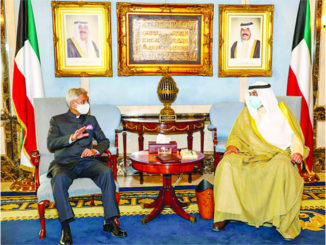
From the ramparts of the historic Red Fort, Prime Minister Narendra Modi delivered his tenth Independence Day speech – he equalled the record of hoisting the tricolour for 10 consecutive times – in which he vowed that the country would become one of the top three economies of the world and that the nation now identified as a ‘Vishwamitra’.
Sporting a multicolor Rajasthani bandhani print turban with an off-white kurta and churidar, PM Modi in his Independence Day speech highlighted how his government had brought transformation to the nation and added that decisions and actions taken during the “Amrit Kaal” – the period until 2047, the centenary of India’s Independence – will impact the millennium to come. “The decisions we make in this Amrit Kaal, our actions and sacrifices, would pave the way for a glorious history spanning the next millennium,” PM Modi said, adding, “The events of this era will impact the next millennium.”
During his speech, Prime Minister Modi also spoke of the various schemes his administration has launched since coming to power and also made the announcement of a new scheme – the Vishwakarma Yojana.
Let’s take a closer look at what this new scheme entails and also the other ones he mentioned in his address to the nation.
Vishwakarma Yojana
Addressing the nation on the occasion of the 77th Independence Day, Prime Minister Narendra Modi announced the Vishwakarma Yojana for traditional workers and craftsmen with an initial allocation of Rs 13000- Rs 15,000 crore.
PM Modi said, “In the coming months we will launch Vishwakarma yojana for those who work with their tools, such as goldsmiths, ironsmiths, washermen, hair-dressers and masons who mostly come from the OBC class.”
The scheme will be flagged on Vishwakarma Jayanti, 17 September and seeks to help workers from the OBC community such as barbers, tanners, and blacksmiths. The scheme, according to the prime minister, carries the objective to drive economic growth and social progress among individuals possessing traditional skills.
The Vishwakarma scheme was initially announced in this year’s Budget presented by Finance Minister Nirmala Sitharaman. At the time, it was said that the scheme aimed at improving the quality, scale and reach of products and services of artisans and craftspeople and to integrate them with the domestic and global value chain.
The finance minister had said that this would result in the economic empowerment of such workers, especially those belonging to the Scheduled Castes, Scheduled Tribes, Other Backward Communities, women, transgender and other weaker sections of the society.
The PM had hailed the scheme at the time of its announcement, saying: “There are many of them (artisans) who can become suppliers and producers for our MSME sector. The industrial world can increase production by linking these people with their needs.”
Drone training for women
Apart from the Vishwakarma Yojana, PM Modi also made mentions of other schemes and announced a new scheme for women in which they would be trained to operate and repair drones. Pitching the importance of technology in agriculture, he said that 15,000 women self-help groups would be given training to handle and repair drones.
“We will train them in operating and repairing drones. Many self-help groups will be provided with drones. These agricultural drones can be utilised effectively. The initiative will begin with the flight of drones by 15,000 women’s self-help groups,” he said.
Increase in Jan Aushadi Kendras
Speaking on the occasion of the 77th Independence Day, PM Modi said that his government is working to increase the number of ‘Jan Aushadhi Kendras’ from 10,000 to 25,000. These centres are a part of the larger scheme, the Pradhan Mantri Bhartiya Janaushadi Pariyojana that aims to provide quality medicines at affordable prices to the masses.
PM Modi in his speech said that holistic healthcare was the demand of the hour after COVID-19, adding that his government had even established a separate Ayush department and now the world is taking note of Ayush and Yoga.
“The world is now watching us because of our commitment,” Modi said, adding that India has emerged as “Vishwa Mitra” (friend of the world) in the post-COVID period.
Earlier in March, Bhupender Yadav, a minister in the Modi government, had said that more than 9,000 Jan Aushadhi Kendras had been opened across the country by the central government to make healthcare accessible to people.
Housing scheme
PM Modi also announced that his government was planning a scheme in which those who were living in substandard conditions would get receive relief on the interest that they would pay on debt that they would undertake towards proper housing.
Such beneficiaries would be those living in slums, unauthorised settlements, ‘jhopdis’ and ‘jhuggis’, largely in urban areas.
PM Modi already has the Pradhan Mantri Awas Yojan -Urban (PMAY-U), which was launched in 2015. Under this scheme, around 1.18 crore houses have already been sanctioned until 31 July, out of which 76.02 lakh have been delivered to the beneficiaries.
Prime Minister Modi also used the opportunity to highlight his government’s other achievements and his vision for the country. According to many poll pundits, this speech gains even more significance, as it his last before the 2024 general elections.
And Modi ensured that he spoke of his governance in his speech which also saw him ditching the regular ‘Mitron’ address and repeatedly referring to the people as ‘parivaarjan’, which means family members. In fact, at the end of his speech, he explained why he used ‘parivaarjan’, saying, “I am one of you. I have come from amid you. My sweat is for you. I work for you not because you entrusted me with the responsibility. I do it because you are my family members. And I can’t see your suffering, your dreams crashing.”





Be the first to comment